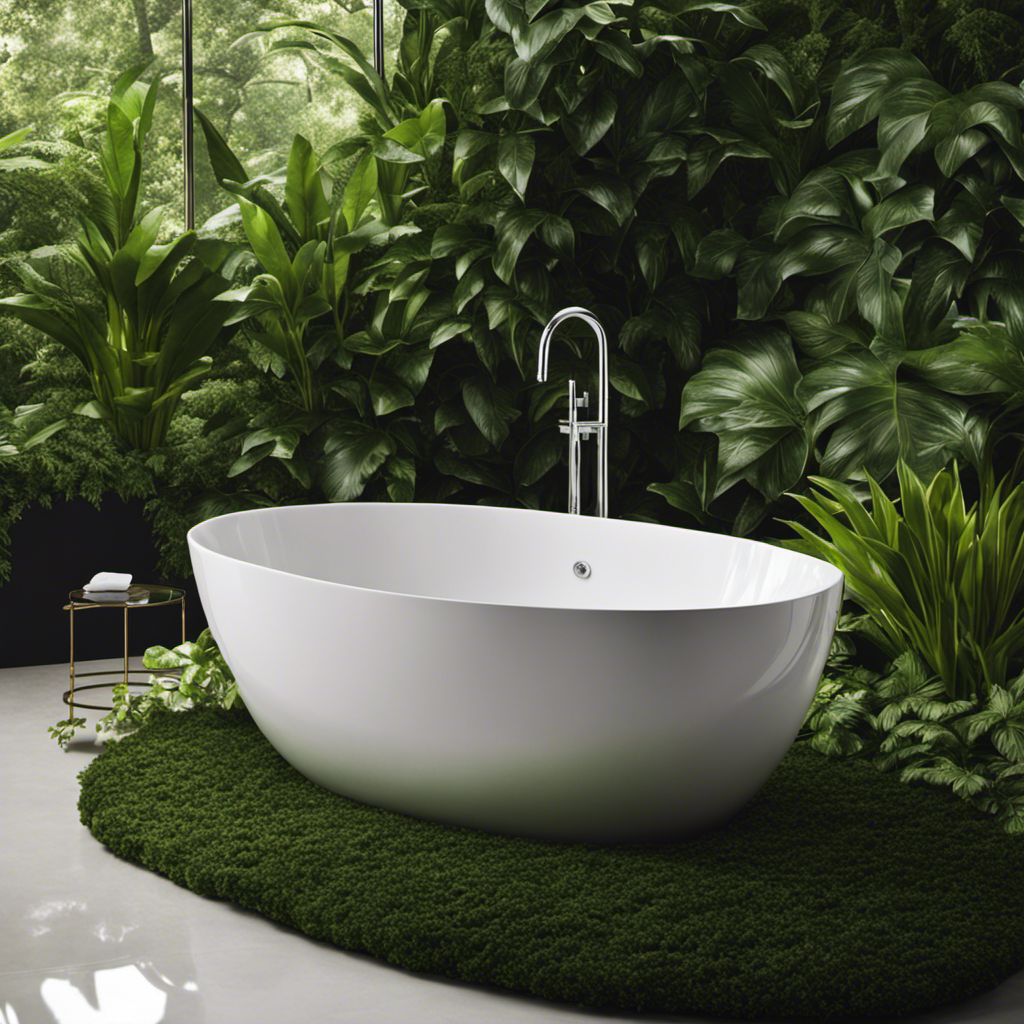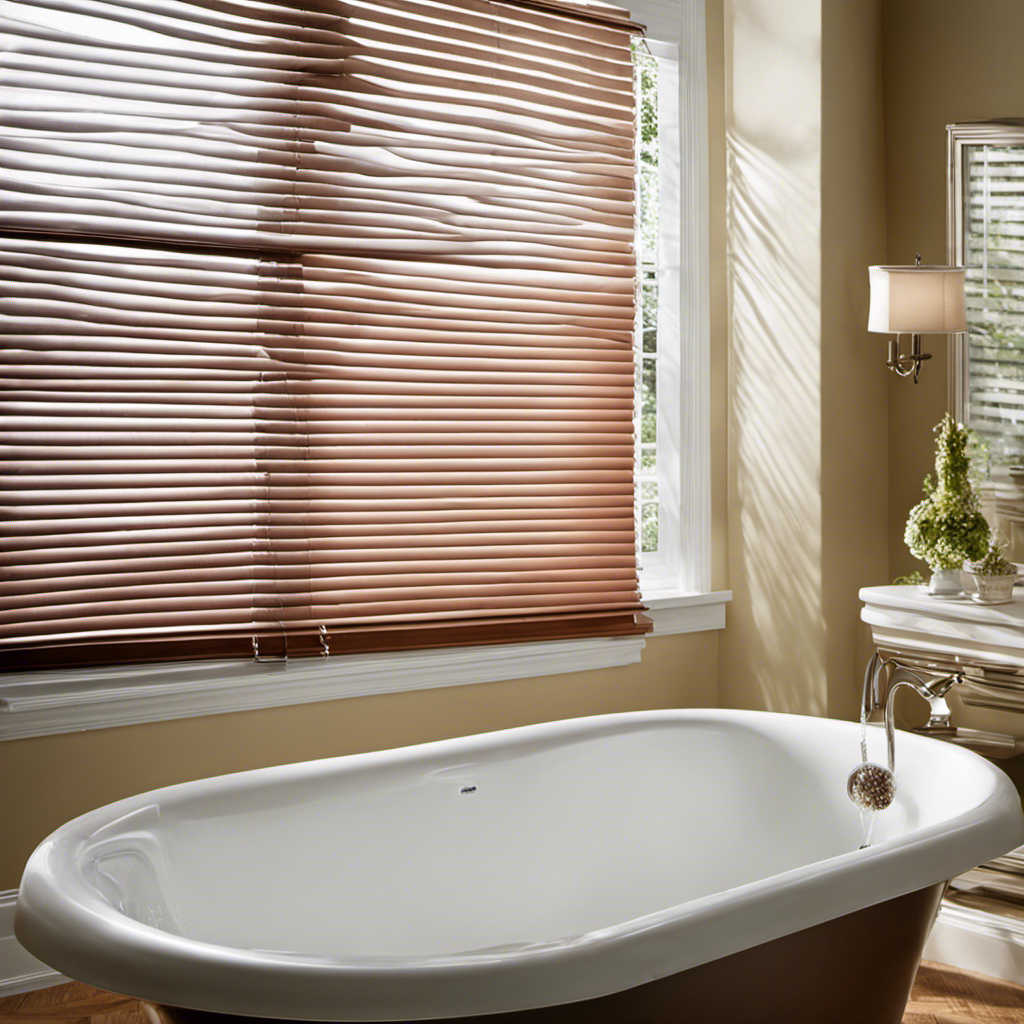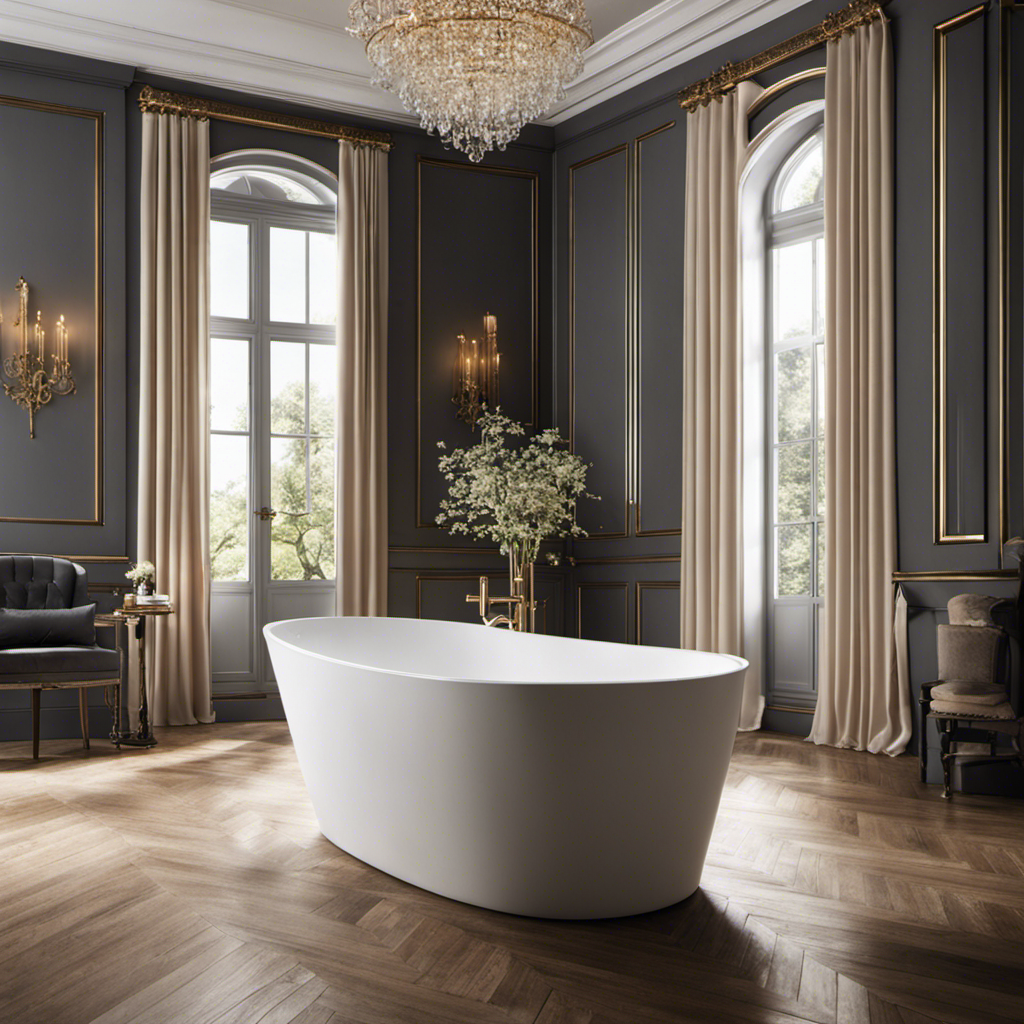I’ve searched high and low to find the absolute best bathtub material out there, and let me tell you, the results are mind-blowing!
In this article, I’ll break down the durability, maintenance requirements, cost considerations, aesthetics, heat retention, insulation properties, and environmental impact of various bathtub materials.
So if you’re tired of settling for subpar tubs, get ready to discover the ultimate bathing experience. Trust me, you won’t want to miss this!
Key Takeaways
- Acrylic, fiberglass, and cast iron are durable materials for bathtubs, with cast iron being the most long-lasting option.
- Porcelain and stone require special care and maintenance, as they are prone to chipping and scratching.
- Acrylic and fiberglass bathtubs have lower upfront costs and low maintenance requirements, making them more affordable options.
- Cast iron and copper bathtubs have excellent heat retention properties and a luxurious appeal, while acrylic and fiberglass are less effective at preventing heat transfer.
Durability of Bathtub Materials
The durability of different bathtub materials can vary greatly. When choosing a bathtub, it’s important to consider both the lifespan and strength of the material.
Some common bathtub materials include acrylic, fiberglass, cast iron, and porcelain. Acrylic is known for its durability and can last for many years with proper care. Fiberglass is also a durable option and is resistant to cracking or chipping. Cast iron bathtubs are incredibly strong and are known for their longevity, often lasting for decades. Porcelain, while elegant and classic, may not be as durable as the other materials and can be prone to chipping or scratching.
It’s important to choose a bathtub material that suits your needs and will withstand daily use.
Now that we’ve discussed the durability of different materials, let’s explore the maintenance requirements of each.
Maintenance Requirements of Different Bathtub Materials
When it comes to maintaining different types of bathtubs, homeowners often wonder about the specific requirements. It’s important to understand that each bathtub material has its own maintenance needs. Here are some key points to consider:
-
Acrylic: This material is low-maintenance and easy to clean. Avoid using abrasive cleaners that can scratch the surface.
-
Porcelain: Regular cleaning with a non-abrasive cleaner is usually sufficient. Be careful not to chip or crack the porcelain.
-
Fiberglass: Clean with a non-abrasive cleaner and avoid using harsh scrubbing tools that can damage the surface.
-
Cast iron: This material requires regular cleaning with a non-abrasive cleaner to prevent staining and rusting.
-
Stone: Stone bathtubs need special care, including regular sealing and using non-acidic cleaners to avoid damage.
Cost Considerations for Bathtub Materials
To determine which bathtub material might be the most cost-effective option for you, consider factors such as installation, maintenance, and longevity. When it comes to bathtub material costs, it’s important to weigh the upfront expense against the long-term benefits. Some materials may require more maintenance or be less durable, leading to higher costs over time. Here is a table comparing the cost effectiveness of different bathtub materials:
| Material | Cost | Maintenance | Longevity |
|---|---|---|---|
| Acrylic | $$ | Low | Long |
| Fiberglass | $ | Low | Medium |
| Porcelain | $$$ | Medium | Long |
| Cast Iron | $$$$ | High | Longest |
As you can see, acrylic and fiberglass are more cost-effective options due to their lower upfront costs and lower maintenance requirements. However, if you’re willing to invest more upfront for a longer-lasting material, porcelain or cast iron may be worth considering. Now, let’s explore the aesthetics and style options of these different bathtub materials.
Aesthetics and Style Options of Bathtub Materials
When it comes to choosing a bathtub, the material used can have a significant impact on the overall aesthetics of your bathroom. Different materials offer various styles and finishes, allowing you to achieve the desired look and feel for your space.
Additionally, it is crucial to consider the compatibility of the material with your bathroom’s design, ensuring that it complements the existing elements and creates a cohesive look.
Material Impact on Aesthetics
If you want a bathtub that looks stylish and modern, acrylic or porcelain would be your best options. These materials have a visual impact that can elevate the overall aesthetic of your bathroom.
Here are some key points to consider when choosing a bathtub material:
-
Acrylic: This material is lightweight, durable, and easy to clean. It comes in a variety of shapes and colors, allowing for design flexibility.
-
Porcelain: Known for its classic and timeless appeal, porcelain is a popular choice for traditional or vintage-inspired bathrooms.
-
Fiberglass: This material is affordable and lightweight, making it a practical choice for budget-conscious homeowners.
-
Cast iron: While heavy and expensive, cast iron bathtubs have a luxurious and elegant look that can become a focal point of your bathroom.
-
Stone: Natural stone bathtubs, such as marble or granite, exude luxury and sophistication, adding a touch of opulence to any bathroom design.
Considering these options, you can select a bathtub material that not only meets your aesthetic preferences but also fits your budget and lifestyle.
Style Choices and Compatibility
For a stylish and compatible look, consider the different shapes and colors available with acrylic and porcelain tubs.
When it comes to style choices, these two materials offer a wide range of options. Acrylic tubs are known for their versatility, as they can be molded into various shapes and sizes, allowing for unique and modern designs. They also come in a variety of colors, from classic whites to bold and vibrant hues.
On the other hand, porcelain tubs exude elegance and sophistication with their smooth and glossy finish. They are available in traditional white, which adds a timeless appeal to any bathroom decor.
Both materials are compatible with different bathroom styles, so it ultimately comes down to personal preference and the overall aesthetic you wish to achieve.
Heat Retention and Insulation Properties of Bathtub Materials
When it comes to choosing a bathtub, it’s important to consider the material’s heat retention and insulation properties. The right bathtub material can help keep your bathwater warm for longer periods of time, providing a more enjoyable and relaxing bathing experience.
Additionally, a bathtub with good insulation can help conserve energy and reduce heating costs. So, if you’re in the market for a new bathtub, it’s worth exploring the options available to find the best heat-resistant bathtub that suits your needs.
Material and Heat Retention
To maximize heat retention in your bathtub, opt for a material like cast iron or copper. These materials have excellent insulation and energy efficiency properties, which help to retain heat for longer periods of time.
The thermal conductivity of cast iron and copper is lower compared to other materials like acrylic or fiberglass. This means that they are better at preventing heat transfer from the hot water to the surrounding environment.
As a result, you can enjoy a longer and more comfortable soak in your bathtub without the water cooling down quickly.
Additionally, cast iron and copper bathtubs have a luxurious and timeless appeal, making them a stylish addition to any bathroom.
Insulation and Bathtub Materials
Using materials like cast iron or copper for your bathtub can help maximize heat retention and keep the water warm for longer periods of time.
Insulation is crucial when it comes to maintaining the temperature of your bathwater. Proper insulation benefits include reducing heat loss and increasing energy efficiency. There are various insulation options available for bathtubs, such as foam insulation or insulating panels.
Foam insulation is a popular choice as it provides excellent heat retention properties and is easy to install. Insulating panels, on the other hand, offer additional benefits like soundproofing and moisture resistance.
By incorporating insulation into your bathtub, you can enjoy longer and more comfortable baths without worrying about the water cooling down quickly.
Now, let’s explore the best heat-resistant bathtub options for ultimate bathing pleasure.
Best Heat-Resistant Bathtub
Insulation is key for maintaining optimal water temperature in your tub. When it comes to choosing the best heat-resistant bathtub material, there are several factors to consider.
Here’s a comparison of different bathtub materials and their heat resistance:
-
Acrylic: This material offers good heat retention and insulation properties, keeping your bathwater warm for longer periods.
-
Cast Iron: Known for its excellent heat retention, cast iron tubs are great at keeping water hot for extended periods.
-
Fiberglass: While fiberglass is not as heat-resistant as acrylic or cast iron, it still provides decent insulation to maintain water temperature.
-
Porcelain-Enameled Steel: This material has good heat resistance and can retain water temperature effectively.
-
Solid Surface: Solid surface bathtubs have good heat retention and insulation properties, ensuring your bathwater stays warm.
Understanding the heat resistance of different bathtub materials is crucial in making an informed decision for your bathroom.
Now, let’s delve into the environmental impact of these bathtub materials.
Environmental Impact of Bathtub Materials
If you’re concerned about the environmental impact of bathtub materials, you may want to consider options like cast iron or recycled acrylic. When it comes to sustainability concerns and eco-friendly options, these materials are a great choice. Cast iron is durable and long-lasting, reducing the need for frequent replacements. It also has excellent heat retention properties, allowing you to enjoy a warm bath for longer periods without using excessive hot water. Recycled acrylic, on the other hand, is made from post-consumer materials, reducing the demand for new resources. It is also lightweight, making it easier to install and transport. Both options offer a balance between functionality and environmental responsibility. By choosing these materials, you can enjoy your bath knowing that you are making a positive impact on the planet.
| Material | Sustainability | Eco-Friendly | Durability |
|---|---|---|---|
| Cast Iron | High | Yes | Excellent |
| Recycled Acrylic | High | Yes | Good |
| Other Materials | Varies | No | Varies |
Conclusion
After careful consideration of the durability, maintenance, cost, aesthetics, heat retention, insulation properties, and environmental impact of various bathtub materials, it is clear that there is no one-size-fits-all answer to the question of which material is best.
However, it is safe to say that each material has its own unique advantages and disadvantages. As the saying goes, ‘Beauty is in the eye of the beholder.’
Therefore, when it comes to choosing the best bathtub material, it ultimately boils down to personal preference and individual needs.










